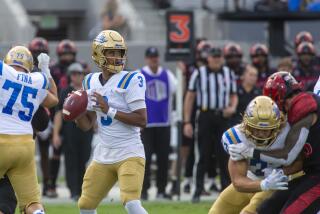St. Nick’s Visit: Gift From a Loving Father : Tradition: In old Manhattan, a poem was born. Here is the story of the legacy left to children all over the world.
NEW YORK — It was Christmas Eve, 1822, and snow lay deep over old New York, the downtown streets and the farmland that was most of the island of Manhattan. Sleigh bells jingled but “Jingle Bells” would not be sung for another 35 years.
Clement Clarke Moore, a 43-year-old teacher at an Episcopal seminary, had been at work for weeks with his quill, crafting a secret present for his six children. Now it was done.
Earlier that day, Moore rode out in his carriage on Christmas errands with his servant, Patrick. He returned to his four-story brick farmhouse with the largest turkey he could find in Washington Market’s crowded pens at the tip of the island.
After dinner, the family retired to the parlor to sit in front of the hearth, with its warming fire. And Moore unveiled his Christmas gift. The children--Margaret, Charity, Benjamin, Mary, and Clement, Jr.--sat at his feet. Infant Emily was in her mother’s arms.
He began to read:
‘Twas the night before Christmas, when all through the house
Not a creature was stirring--not even a mouse. . . .
When he finished, “Happy Christmas to all, and to all a good night!” there was silence, then exultation. The children prevailed on him to read it again and joined in on lines they remembered. Bedtime interrupted their pleas for a third reading.
“A Visit from St. Nicholas” was born, and with it a vision of the sainted gift-giver that would decorate the American Christmas, its street corners and department stores, its trees and cards for decades to come. In the 170 years since, children all over the world have held the poem and the image of Santa Claus in their hearts.
His eyes--how they twinkled! His dimples how merry!
His cheeks were like roses, his nose like a cherry!
His droll little mouth was drawn up like a bow,
And the beard of his chin was as white as the snow. . .
He had a broad face and a little round belly
That shook, when he laughed, like a bowl full of jelly.
He was chubby and plump, a right jolly old elf,
And I laughed when I saw him in spite of myself. . . .
In the years to follow the history of the poem took a curious turn. Though it was cherished immediately, Moore would not acknowledge his authorship publicly for 15 years, say Gerard and Patricia del Re in their book, “ ‘Twas The Night Before Christmas.”
Although it was passed from hand to hand and copied, it was two days before the next Christmas, in 1823, that the Troy (N.Y.) Sentinel published it for the first time. It was unsigned and prefaced with this, from the newspaper’s editor:
“We do not know to whom we are indebted for the following description of that unwearied patron of children--that homey and delightful personage of parental kindness--Santa Claus . . . as he goes about visiting the firesides of this happy land, laden with Christmas bounties; but from whomsoever it may have come, we give thanks for it.”
Perhaps Moore thought it too frivolous an enterprise for a scholar and teacher of Oriental languages and Hebrew, author of “A Compendious Lexicon of the Hebrew Language” and pious patron of the Episcopal Church. Or perhaps he meant the poem only as a private communion with his children, his family.
He finally consented to sign his name to it on a reprinting in the New York Book of Poetry in 1837.
The poem is based in part on an old Dutch myth of which Moore’s friend, Washington Irving, wrote in his “Knickerbocker’s History of New York.”
In fact, there are some similarities between the two texts. Irving saw the smoke from St. Nick’s pipe “like a cloud overhead.” Moore said “it encircled his head like a wreath.” Irving: “And laying a finger beside his nose.” Moore: “his finger aside of his nose.” Irving: “remounting his wagon he returned over the treetops and disappeared.” Moore: “And giving a nod up the chimney he rose.”
Irving’s aim was satire; Moore’s was a simple, innocent tale of goodness and giving.
Moore had other things on his mind that Christmas season, as well. He stopped regularly to view the construction of the General Theological Seminary, which he helped build. He gave almost the entire Chelsea section of the city to the Episcopal Diocese and helped build nearby St. Peter’s Church, which still stands.
The city-ordained grid of streets had not yet reached Chelsea, where the few graceful farmhouses were linked by dirt lanes. To the south, the shanties of Greenwich Village were about to give way to the rising city. Moore railed against the dissection of the countryside by streets and avenues laid out in unforgiving rectangles. It was a fight he would lose.
It was part of the romantic spirit of this scholar with a long face and prominent nose--the son of another scholar who became president of Columbia University--to want the homes and churches of Chelsea connected by curving streets and winding lanes.
Moore was a romantic, say both the Del Res and the Rev. Wray MacKay, today’s rector of St. Peter’s. This was evidenced by his letters of courtship to his wife, Eliza, and by his dedication to the church, which at one time was the only source of education for the poor children of the shantytown to the south.
“The church is a highly romantic building,” parishioner and architectural scholar Chris Jenks said. “Almost a stage set.” Not quite Gothic, but trying to capture the feeling of the Middle Ages.
And the poem itself. “It has the qualities of imagination and fantasy and energy, and that’s why it endures,” MacKay said. “You read it and you just get caught up in it.”
MacKay sees something more than good fortune in the fact that when stones from the tower began to fall into the street a few years ago, the archdiocese put up $500,000 to repair it. It only cost $65,000 to build the church in the 1830s, and Moore paid for most of it. He also bought the pine pew on the right-hand front of the nave for $200, in perpetuity. The deed exists still.
As does the seminary, which schooled fewer than two dozen seminarians a year when it opened and more than 150 now.
The Moores are not buried at St. Peter’s. For public health reasons, Moore attached a covenant to the deed that there there would be no burial grounds in Chelsea. He and his family were interred at St. Luke’s in Greenwich Village, but their remains were moved to the Church of the Intercession in the Bronx when St. Luke’s future was in doubt at the turn of the century.
That neighborhood now is mostly poor Latino and black, but the church and its parish house are elegant reflections of its past. It is built on the old James Audubon farm. Audubon is buried on the grounds, as is Alfred Dickens, a son of Charles Dickens who died in New York while on a trip with his father. His grave was long honored yearly at this time of year by New York’s Dickens Society members in period dress.
Now, every Christmas season, after a reading of the poem at the Church of the Intercession, parishioners and their children troop down the long, steep slope toward the Hudson River to the west graveyard.
Next week, led by a St. Nicholas in gold miter and white gown, they will stream past the prestigious mausoleums where lie important New York families such as the Astors and the Cushmans, and they will pay homage to the poet’s grave and those of the Moore family who heard the poem first.
More to Read
Sign up for Essential California
The most important California stories and recommendations in your inbox every morning.
You may occasionally receive promotional content from the Los Angeles Times.










